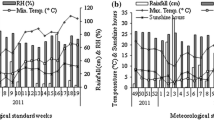Abstract
THE development of Fragaria vesca L. var. semperflorens Duch. is very sensitive to day-length1. In short-day conditions the plants do not reach the reproductive stage. Days more than 12 hr. long are required. Short-day treatment also inhibits flower formation of Fragaria vesca plants which have previously reached the flowering stage in long-day conditions. During a season in the open field, the number of flowers found on such flowering plants varies according to the day-length as shown in Fig. 1. A maximum of flowers is found in the inflorescences growing during August–October, which have been initiated during June–July, in the longest days.
Similar content being viewed by others
References
Sironval, C., C.R. Rech. IRSIA, Bruxelles, 18, 1 (1957).
Meunier, E., and Vinet, A., C.R. Acad. Sci., Paris, 211, 611 (1940).
Kjölhede, K., Z. Vitaminforsch., 12, 138 (1942).
Author information
Authors and Affiliations
Rights and permissions
About this article
Cite this article
SIRONVAL, C., TANNIR-LOMBA, J. Vitamin E and Flowering of Fragaria vesca L. var. semperflorens Duch.. Nature 185, 855–856 (1960). https://doi.org/10.1038/185855a0
Issue Date:
DOI: https://doi.org/10.1038/185855a0
- Springer Nature Limited
This article is cited by
-
Components of cottonplant leaves, their functional role and biological activity
Chemistry of Natural Compounds (1997)
-
The effects of 3-indoleacetic acid, gibberellic acid and vitamin E on flower initiation in unvernalised Petkus winter rye plants
Die Naturwissenschaften (1963)





